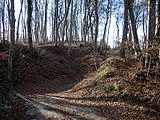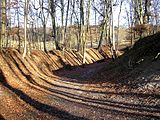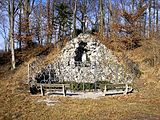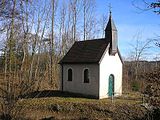Burgstall Wildenroth (Grafrath)
| Burgstall Wildenroth | ||
|---|---|---|
|
The Burgstall on the Amperleite |
||
| Creation time : | 13th Century | |
| Castle type : | Hilltop castle | |
| Conservation status: | Burgstall | |
| Place: | Grafrath | |
| Geographical location | 48 ° 7 '30 " N , 11 ° 10' 12" E | |
|
|
||
The Postal Wildenroth denotes a Outbound high medieval hilltop castle on the Amper Leite over the Grafrather Gemeindeteil Wildenroth in the district of Fürstenfeldbruck in Upper Bavaria . The ground monument was impaired around 1900 when a Lourdes grotto was built and a new chapel was built.
history
The castle was probably built in the first half of the 13th century over an important amperage. However, there is no direct evidence of such a bridge or ford in the historical sources. The conflict between the dukes of Bavaria and the powerful counts of Andechs can be assumed as the political background to the new castle building . The counts could thus be cut off from their possessions north of the Amper.
The Wittelsbachers gave the fortress as a fiefdom to Konrad von Hegnenberg, who from then on named himself after his new castle. The Hegnenberger was considered one of the most loyal followers of the Duke, whom he also served as a financial advisor and marshal . At the end of the 13th century, however, he was involved in a feud and ostracized by the Munich court in 1297 because of the manslaughter of his fugitive son Engelschalk against her relative Winhart von Rohrbach zu Althegnenberg . Konrad von Wildenroth was expelled from the country and sentenced to pay an annual "Herrenvalue" of 22 pounds pfennigs. After the compensation of the Rohrbachers and the lifting of the eight he was able to return to his property and was appointed court master by the duke .
During the division of Upper Bavaria (1310), Wildenroth became part of the Ingolstadt part of Duke Ludwig IV . The future emperor pledged the rule in 1311 for 200 pounds pfennig to Engelschalk von Wildenroth's son Konrad II. In 1319 this Konrad passed the castle with all liens on to his uncle Berthold von Kühlenthal and his nephews Siegfried and Berthold. Three years later, King Ludwig donated the castle and all its accessories to the nearby Fürstenfeld monastery . Around 1350 the fortress seems to have been demolished from the Fürstenfeldern, although the pledges did not cede their claims to the monastery until 1366 in return for the payment of 200 pounds of pounds.
Wildenroth remained a Hofmark of the Fürstenfeld Monastery until 1803 . The remains of the castle disappeared except for the trenches and earthworks. In 1900 the small chapel of St. Leonhard was built on the edge of the main castle and the obelisk above the Lourdes grotto. The inscription on this obelisk indicates the place of the castle as the "Rassoburg" of St. Rasso von Grafrath, which according to local tradition is said to have been destroyed by the Hungarians . This early medieval castle complex is now located in the area of the church of Höfen.
When the grotto and the chapel were built, the southern part of the main castle was severely disturbed. In January 2008, adverse effects from heavy wood harvesting machines in the area of the core plant were also detectable.
description
The Burgstall is located on the northern high bank about 30 meters above the Amper. The ground monument shows the typical two-part system of high medieval castle complexes. The oval floor plan of the fortress is around 150 × 100 meters.
The slightly raised main castle in the west is separated from the outer castle by an approximately three meter deep section trench. The northern area of the trench was modernly affected by heavy timber harvesting machines. The arched outer moat of the outer bailey, up to six meters deep, is in very good condition, with a wall in front of it.
The almost equally large area of the main castle was severely disturbed around 1900 when the Lourdes grotto and the construction of the chapel were built (southern part). In the north and east, the trench to be assumed can only be partially recognized. This area was also affected by forest work after 2000.
The stone obelisk from 1900 with the inscription "Rassoburg 900" stands above the Lourdes grotto in the southeast. The memorial is a foundation of the Wildenroth miller Leonhard Hartl. At the same time, the simple St. Leonhard Chapel was built in the southwest as the successor to the old castle chapel .
The original church was dedicated to St. Consecrated to Nicholas. After the original castle church was demolished, a preserved chapel was built in 1788 on the southern bank of the Amper below the castle.
The plateau of the main castle allows a wide view over the Ampertal and to the south to the Alpine chain . In the High Middle Ages, Burgplatz offered a good way of controlling the sphere of influence of the competing Counts of Andechs.
The Bavarian State Office for Monument Preservation lists the ground monument as a medieval castle stables under monument number D 1-7833-0009.
literature
- Toni Drexler: Grafrath-Wildenroth: The Schlossberg . In: Toni Drexler, Walter Irlinger, Rolf Marquardt (eds.): Fürstenfeldbruck district - archeology between Ammersee and Dachauer Moos . Stuttgart 2007. ISBN 978-3-8062-2079-7 .
- Hans H. Schmidt (Ed.): Sunken castles in the five-lake region between Ammersee and Isar - historical-archaeological reconstructions (working group for local history research in the Würm region). Gauting 2002.
Topographical survey
- Volker Liedke, Peter Weinzierl: Fürstenfeldbruck district (Monuments in Bavaria, Volume I.12). Munich 1996, ISBN 3-87490-574-8 , p. 122.








